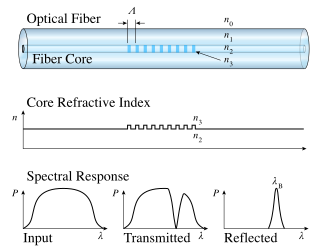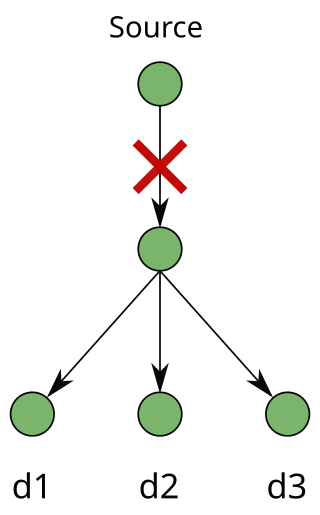
In fiber-optic communications, wavelength-division multiplexing (WDM) is a technology which multiplexes a number of optical carrier signals onto a single optical fiber by using different wavelengths of laser light. This technique enables bidirectional communications over a single strand of fiber as well as multiplication of capacity.
Transaction Language 1 (TL1) is a widely used management protocol in telecommunications. It is a cross-vendor, cross-technology man-machine language, and is widely used to manage optical (SONET) and broadband access infrastructure in North America. TL1 is used in the input and output messages that pass between Operations Support Systems (OSSs) and Network Elements (NEs). Operations domains such as surveillance, memory administration, and access and testing define and use TL1 messages to accomplish specific functions between the OS and the NE. TL1 is defined in Telcordia Technologies Generic Requirements document GR-831-CORE.
Traffic grooming is the process of grouping many small telecommunications flows into larger units, which can be processed as single entities. For example, in a network using both time-division multiplexing (TDM) and wavelength-division multiplexing (WDM), two flows which are destined for a common node can be placed on the same wavelength, allowing them to be dropped by a single optical add-drop multiplexer. Often the objective of grooming is minimizing the cost of the network. The cost of line terminating equipment (LTE) is the most dominant component in an optical WDM network's cost. Thus grooming typically involves minimizing the usage of ADMs.

A passive optical network (PON) is a fiber-optic telecommunications technology for delivering broadband network access to end-customers. Its architecture implements a point-to-multipoint topology in which a single optical fiber serves multiple endpoints by using unpowered (passive) fiber optic splitters to divide the fiber bandwidth among the endpoints. Passive optical networks are often referred to as the last mile between an Internet service provider (ISP) and its customers. Many fiber ISPs prefer this technology.

An add-drop multiplexer (ADM) is an important element of an optical fiber network. A multiplexer combines, or multiplexes, several lower-bandwidth streams of data into a single beam of light. An add-drop multiplexer also has the capability to add one or more lower-bandwidth signals to an existing high-bandwidth data stream, and at the same time can extract or drop other low-bandwidth signals, removing them from the stream and redirecting them to some other network path. This is used as a local "on-ramp" and "off-ramp" to the high-speed network.
Arrayed waveguide gratings (AWG) are commonly used as optical (de)multiplexers in wavelength division multiplexed (WDM) systems. These devices are capable of multiplexing many wavelengths into a single optical fiber, thereby increasing the transmission capacity of optical networks considerably.
In fiber optics, a reconfigurable optical add-drop multiplexer (ROADM) is a form of optical add-drop multiplexer that adds the ability to remotely switch traffic from a wavelength-division multiplexing (WDM) system at the wavelength layer. This is achieved through the use of a wavelength selective switching module. This allows individual or multiple wavelengths carrying data channels to be added and/or dropped from a transport fiber without the need to convert the signals on all of the WDM channels to electronic signals and back again to optical signals.

A fiber Bragg grating (FBG) is a type of distributed Bragg reflector constructed in a short segment of optical fiber that reflects particular wavelengths of light and transmits all others. This is achieved by creating a periodic variation in the refractive index of the fiber core, which generates a wavelength-specific dielectric mirror. Hence a fiber Bragg grating can be used as an inline optical filter to block certain wavelengths, can be used for sensing applications, or it can be used as wavelength-specific reflector.
Optical networking is a means of communication that uses signals encoded in light to transmit information in various types of telecommunications networks. These include limited range local-area networks (LAN) or wide area networks (WANs), which cross metropolitan and regional areas as well as long-distance national, international and transoceanic networks. It is a form of optical communication that relies on optical amplifiers, lasers or LEDs and wavelength-division multiplexing (WDM) to transmit large quantities of data, generally across fiber-optic cables. Because it is capable of achieving extremely high bandwidth, it is an enabling technology for the Internet and telecommunication networks that transmit the vast majority of all human and machine-to-machine information.
An optical cross-connect (OXC) is a device used by telecommunications carriers to switch high-speed optical signals in a fiber optic network, such as an optical mesh network.
A photonic integrated circuit (PIC) or integrated optical circuit is a microchip containing two or more photonic components that form a functioning circuit. This technology detects, generates, transports, and processes light. Photonic integrated circuits utilize photons as opposed to electrons that are utilized by electronic integrated circuits. The major difference between the two is that a photonic integrated circuit provides functions for information signals imposed on optical wavelengths typically in the visible spectrum or near infrared (850–1650 nm).
Wavelength selective switching components are used in WDM optical communications networks to route (switch) signals between optical fibres on a per-wavelength basis.

Digital planar holography (DPH) is a method for designing and fabricating miniature components for integrated optics. It was invented by Vladimir Yankov and first published in 2003. The essence of the DPH technology is embedding computer designed digital holograms inside a planar waveguide. Light propagates through the plane of the hologram instead of perpendicularly, allowing for a long interaction path. Benefits of a long interaction path have long been used by volume or thick holograms. Planar configuration of the hologram provider for easier access to the embedded diagram aiding in its manufacture.
Rod C. Alferness was president of The Optical Society in 2008.

An optical mesh network is a type of optical telecommunications network employing wired fiber-optic communication or wireless free-space optical communication in a mesh network architecture.

Polarization-division multiplexing (PDM) is a physical layer method for multiplexing signals carried on electromagnetic waves, allowing two channels of information to be transmitted on the same carrier frequency by using waves of two orthogonal polarization states. It is used in microwave links such as satellite television downlinks to double the bandwidth by using two orthogonally polarized feed antennas in satellite dishes. It is also used in fiber optic communication by transmitting separate left and right circularly polarized light beams through the same optical fiber.

Wavelength switched optical network (WSON) is a type of telecommunications network.

A multicast session requires a "point-to-multipoint" connection from a source node to multiple destination nodes. The source node is known as the root. The destination nodes are known as leaves. In the modern era, it is important to protect multicast connections in an optical mesh network. Recently, multicast applications have gained popularity as they are important to protecting critical sessions against failures such as fiber cuts, hardware faults, and natural disasters.
An optical module is a typically hot-pluggable optical transceiver used in high-bandwidth data communications applications. Optical modules typically have an electrical interface on the side that connects to the inside of the system and an optical interface on the side that connects to the outside world through a fiber optic cable. The form factor and electrical interface are often specified by an interested group using a multi-source agreement (MSA). Optical modules can either plug into a front panel socket or an on-board socket. Sometimes the optical module is replaced by an electrical interface module that implements either an active or passive electrical connection to the outside world. A large industry supports the manufacturing and use of optical modules.
In optical networking, a lightpath is a path between two nodes in an optical network between which light passes through unmodified.









